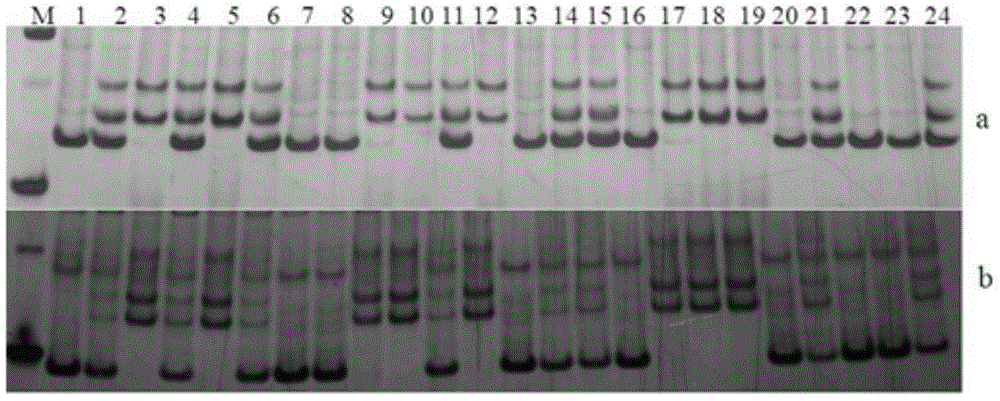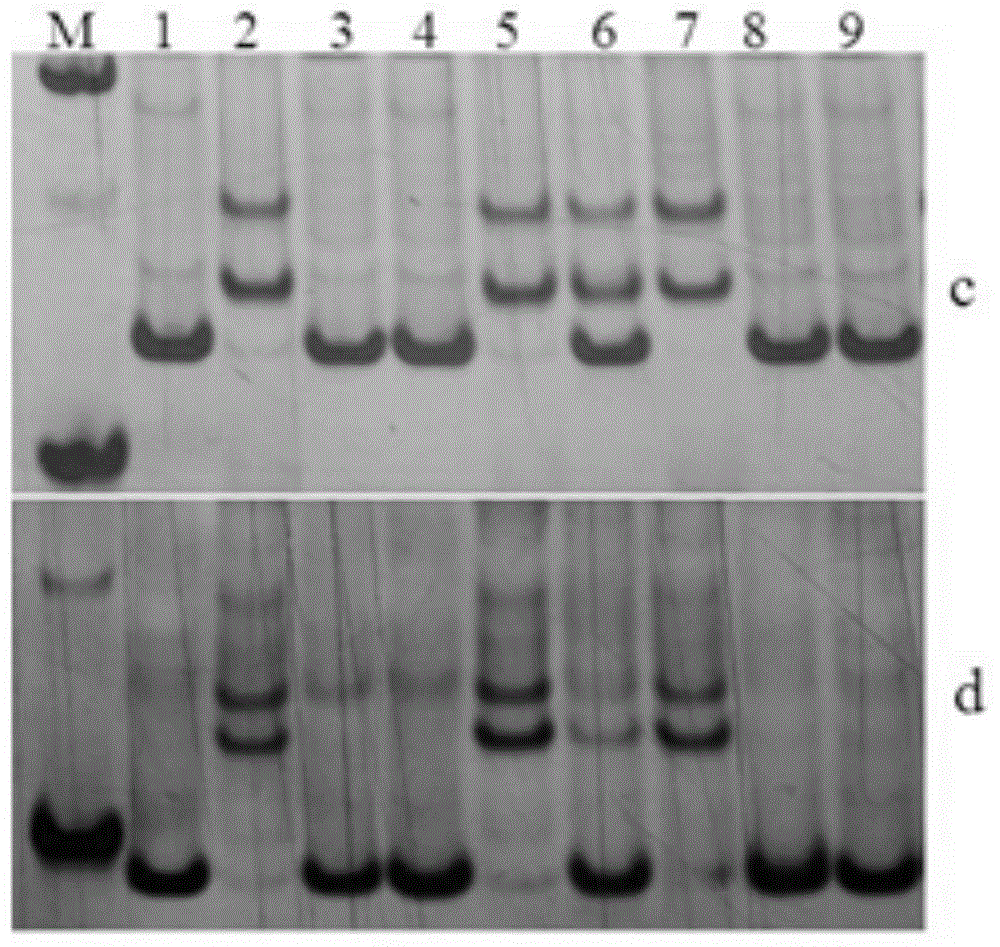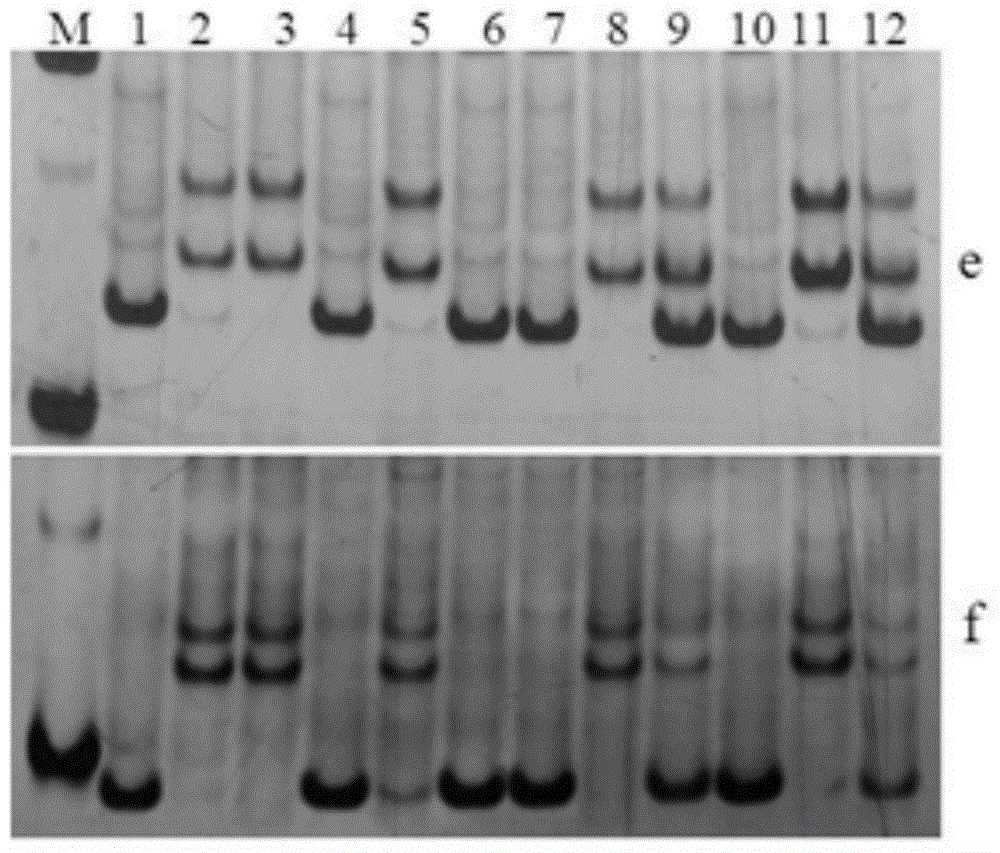Method for detecting SSR molecular marker of pepper male sterility restoring gene as well as kit of SSR molecular marker
A technique for restoring genes and molecular markers, which is applied in biochemical equipment and methods, microbiological determination/inspection, DNA/RNA fragments, etc., and can solve the problems of shortening the breeding process, long breeding cycle, and limited distribution of fertility restoration genes and other problems, to achieve the effect of accelerating the breeding process, good repeatability, and stable and reliable test results
- Summary
- Abstract
- Description
- Claims
- Application Information
AI Technical Summary
Problems solved by technology
Method used
Image
Examples
Embodiment 1
[0039] Embodiment 1, (capsicum male sterility restoration gene Rf development of co-segregated molecular markers)
[0040] Pepper materials described in this example: pepper sterile line 131BC5A; restorer line 139D-21-3; 131BC5A x 139D-21-3 F 1 Generation single plant; 131BC5A x 139D-21-3 F 2 separate groups;
[0041] Parent material and hybridization method:
[0042] ①Parent material:
[0043] Restorer line 139D-21-3: In the spring of 2009, an excellent single plant was discovered from the farm field of Yangdu Village, Xucun Town, Haining City, Zhejiang Province. After obtaining consent, the fruit was harvested and the seeds were collected, and the seeds were purified by self-fertilization for multiple generations. . Restoration line 139D-21-3 can be purchased by the public from Zhejiang Academy of Agricultural Sciences before the date of this patent application. Zhejiang Academy of Agricultural Sciences has distributed this biological material to the public since Octobe...
Embodiment 2
[0054] Embodiment 2, (the capsicum male sterility restoration gene is detected with the marker primer of the present invention)
[0055] Pepper materials described in this example: Pepper sterile line control material: 131BC5A, numbered 1; restorer control material: 139D-21-3, numbered 2; optional pepper recovery materials: numbered 5, 6 and 7; optional pepper Sterile material: numbered 3, 4, 8 and 9;
[0056] The detection method is carried out according to the following steps:
[0057] 1. Extraction of genomic DNA of pepper: Take 0.02-0.05 grams of the young leaves of the pepper samples to be tested at the seedling stage, extract the DNA according to the conventional CTAB method, and store them separately for later use;
[0058] 2. PCR amplification of genomic DNA: Add 1 μL of the genomic DNA of each pepper sample extracted in step (1) to each PCR tube, and then add 5 μL of 2× Taq PCR MasterMix in sequence, and 0.25 μL of the upstream and downstream primers of pep43 or pep2...
Embodiment 3
[0061] Embodiment 3, (use kit of the present invention to the detection of gene restoration of different capsicum materials)
[0062] Pepper materials described in this example: Pepper male sterile line control material: 131BC5A, numbered 1; 11. Optional pepper sterile material: number 4, 6 and 7; maintainer line N(msms) 08-131: number 10; local pepper material 08032: number 12;
[0063] The detection method is carried out according to the following steps:
[0064] 1. Extraction of genomic DNA of pepper: Take 0.02-0.05 grams of the young leaves of the pepper samples to be tested at the seedling stage, extract the DNA according to the conventional CTAB method, and store them separately for later use;
[0065] 2. PCR amplification of genomic DNA: use the primers and reagents provided in the kit for PCR amplification, the amplification volume is 10 μL; add 1 μL of DNA template, 5 μL of 2× Taq PCR MasterMix, 0.25 μL of upstream and downstream primers, Add sterile pure water to 10 ...
PUM
| Property | Measurement | Unit |
|---|---|---|
| Longitudinal diameter | aaaaa | aaaaa |
| Diameter | aaaaa | aaaaa |
Abstract
Description
Claims
Application Information
 Login to View More
Login to View More - R&D
- Intellectual Property
- Life Sciences
- Materials
- Tech Scout
- Unparalleled Data Quality
- Higher Quality Content
- 60% Fewer Hallucinations
Browse by: Latest US Patents, China's latest patents, Technical Efficacy Thesaurus, Application Domain, Technology Topic, Popular Technical Reports.
© 2025 PatSnap. All rights reserved.Legal|Privacy policy|Modern Slavery Act Transparency Statement|Sitemap|About US| Contact US: help@patsnap.com



